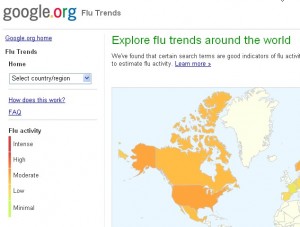
When it comes to tracking flu outbreaks, Google Flu Trends may be more useful to hospitals than government data.
Move over, government health agencies. It turns out Google does a pretty good job tracking the flu. So good, in fact, that researchers at Johns Hopkins University say hospitals may be better off following Google Flu Trends than government data.
They found a strong correlation between spikes in internet searches for flu information and numbers of incoming patients complaining of flu symptoms.
In the United States, doctors traditionally rely on Center for Disease Control & Prevention (CDC) reports to track flu outbreaks. The problem is those reports are slow in coming out–too slow for hospitals and clinics to make daily adjustments to patient volumes.
Google Flu Trends, on the other hand, collects data on a daily basis. It tracks search traffic related to flu information. Users can then drill down to specific regions and timeframes. According to the Hopkins researchers, it’s the real-time aspect that makes Google Flu Trends a useful tool.
Dr. Richard Rothman, the senior investigator on the study, said the long term goal was to develop new monitoring systems:
[A] highly reliable flu surveillance model that all emergency departments could use to reasonably predict a spike in the number of flu-like cases […] Such a system could help emergency department directors and other senior administrators prepare by beefing up staffing or opening up patient annexes.
Obviously such a system would have a major impact on medicine outside the US as well. Rothman & co.’s research seems to point to the possibility of creating a global, real-time monitor of flu activity hospitals around the globe could use.
In the meantime, Google Flu Trends remains a pretty useful tool. Check it out and follow the flu’s spread near you. If the Hopkins study is anything to go by, you’ll have a better picture of the situation than your local health authorities!
